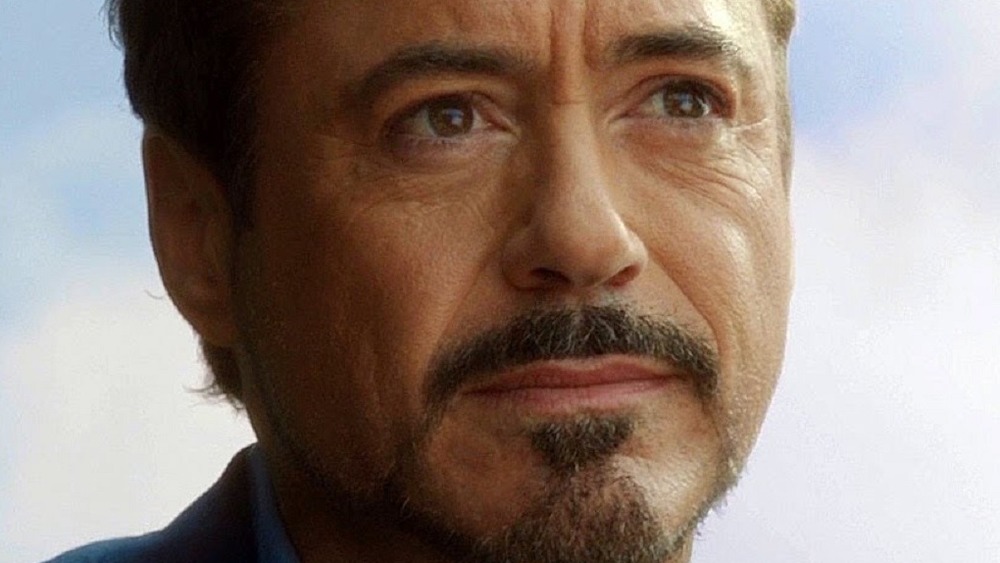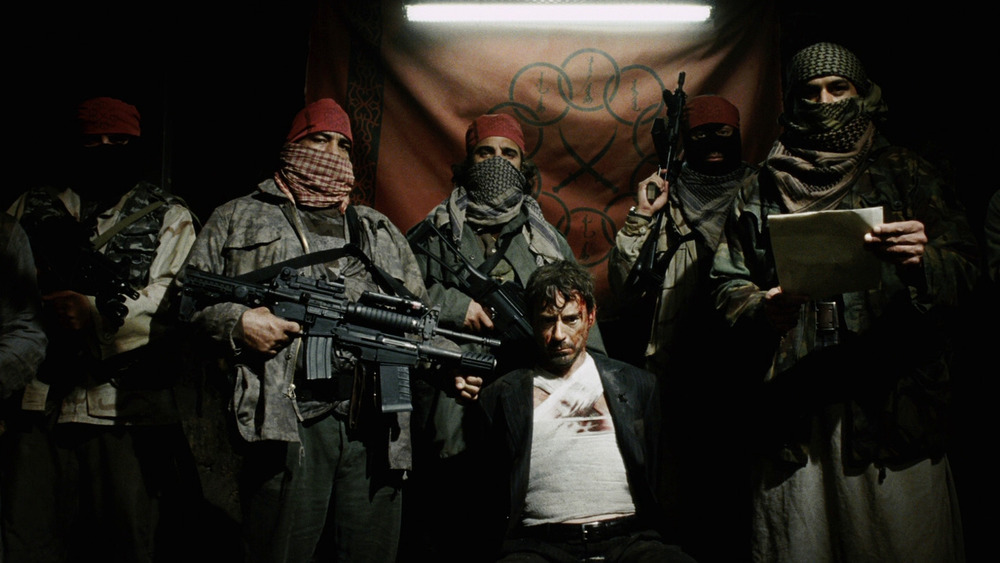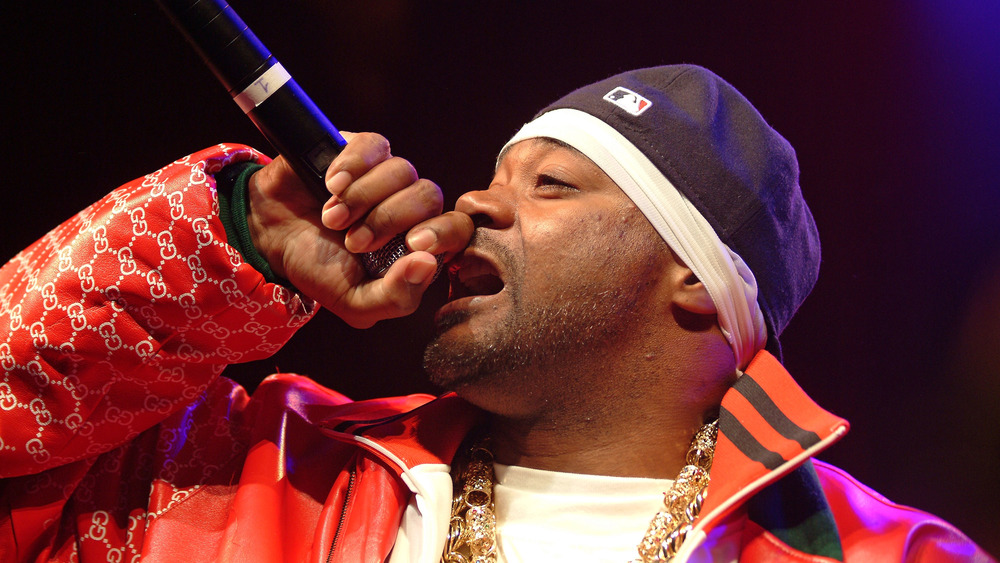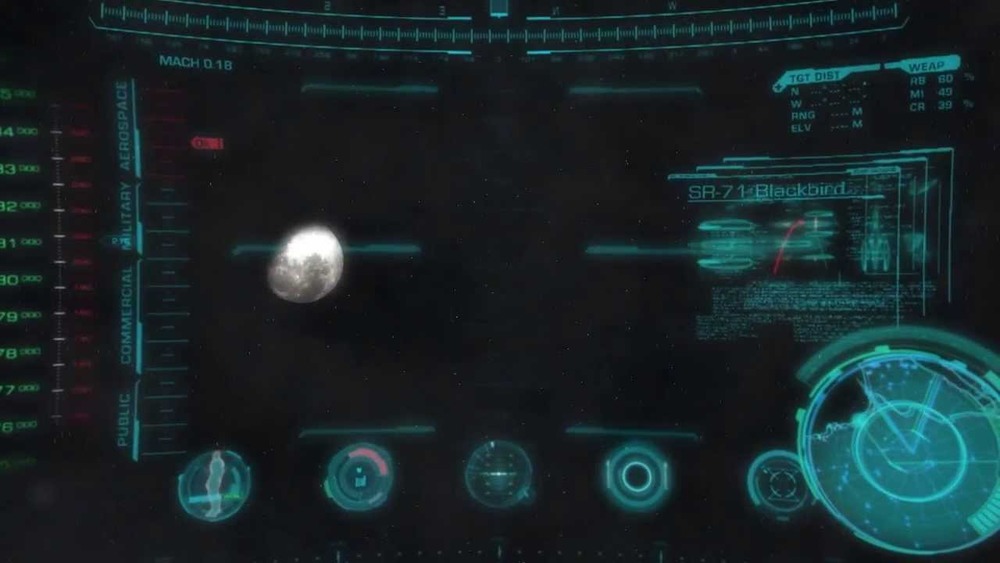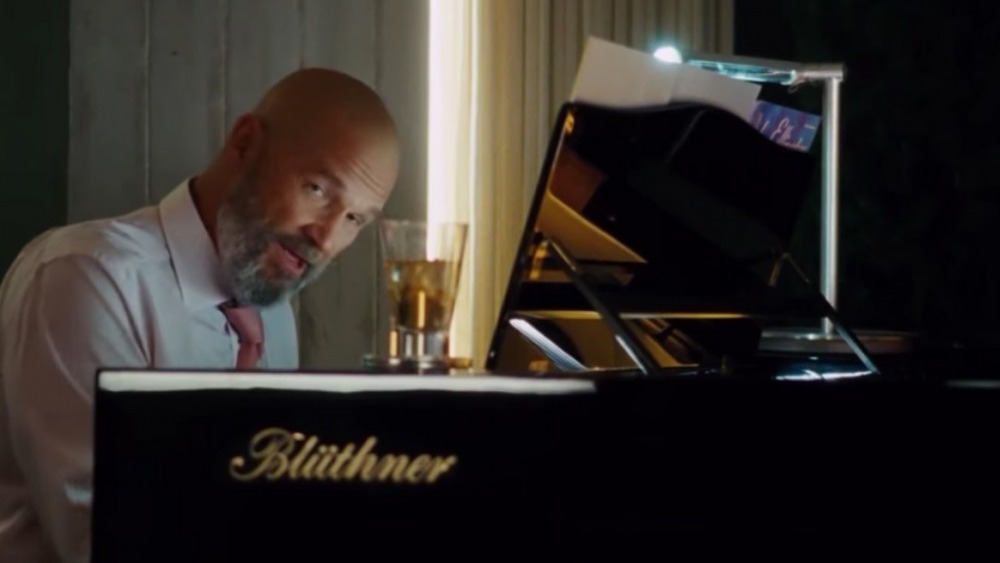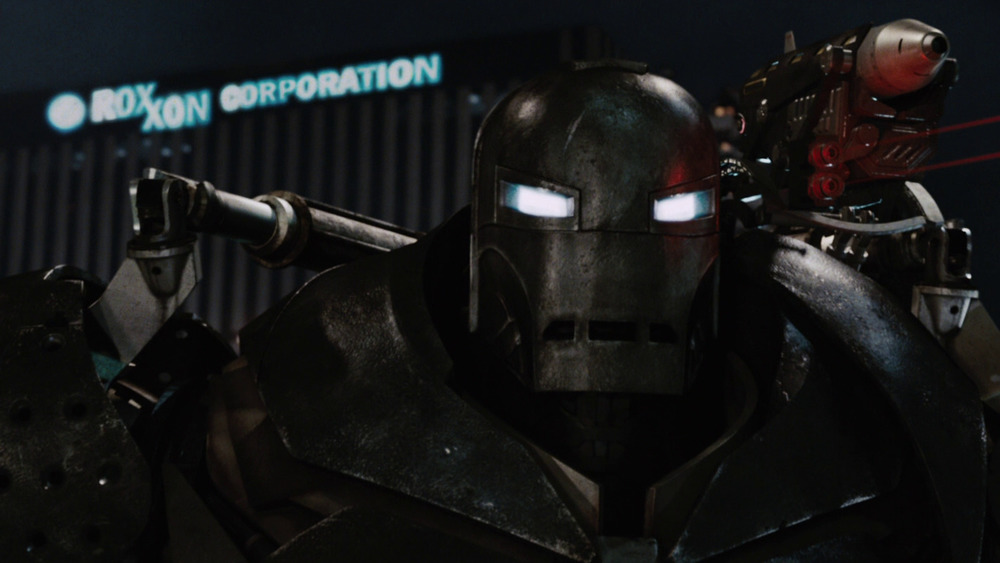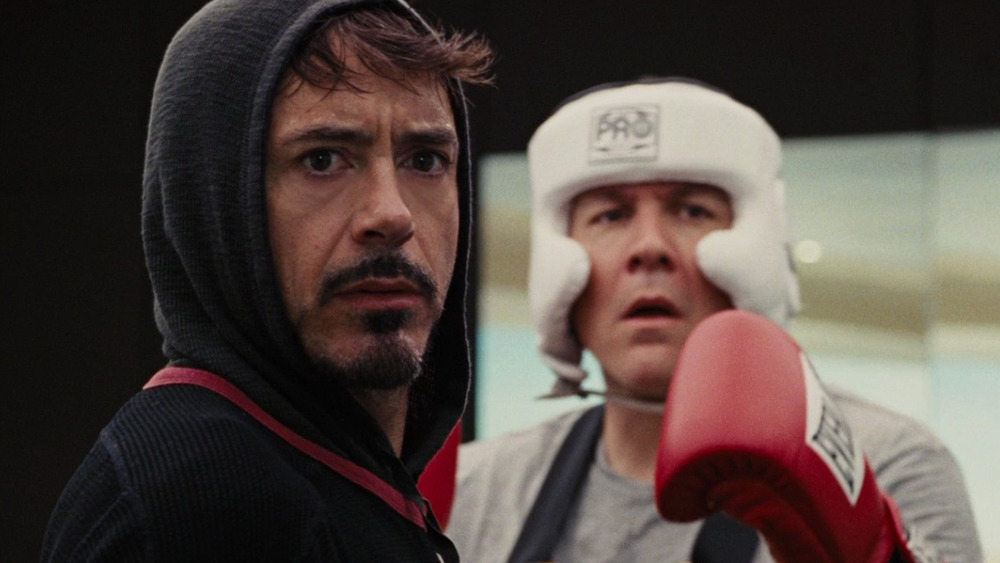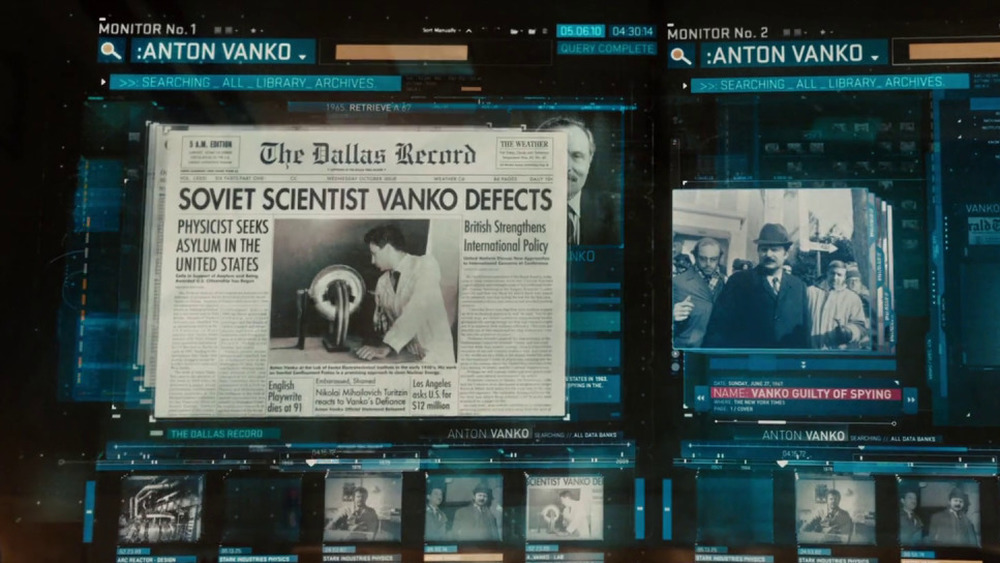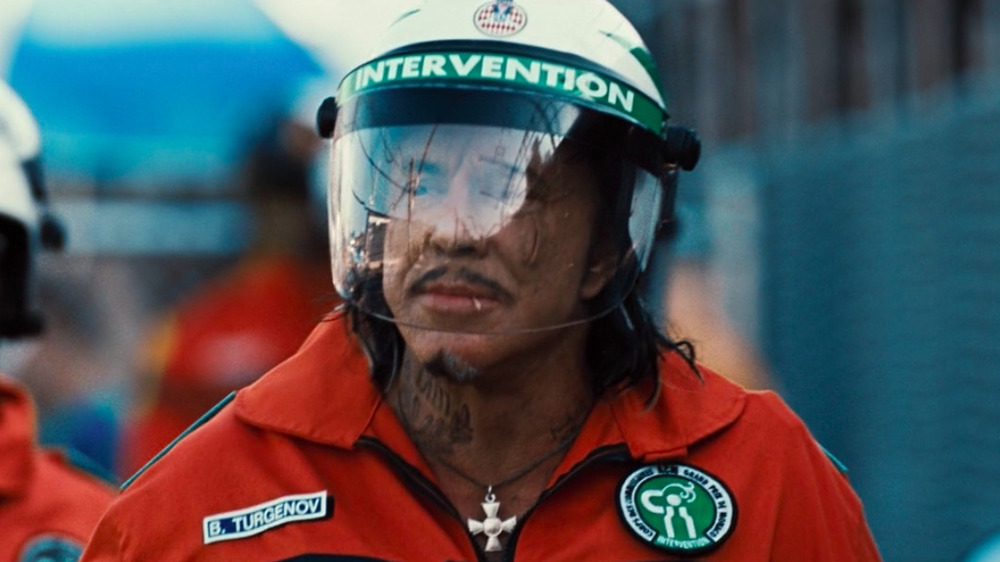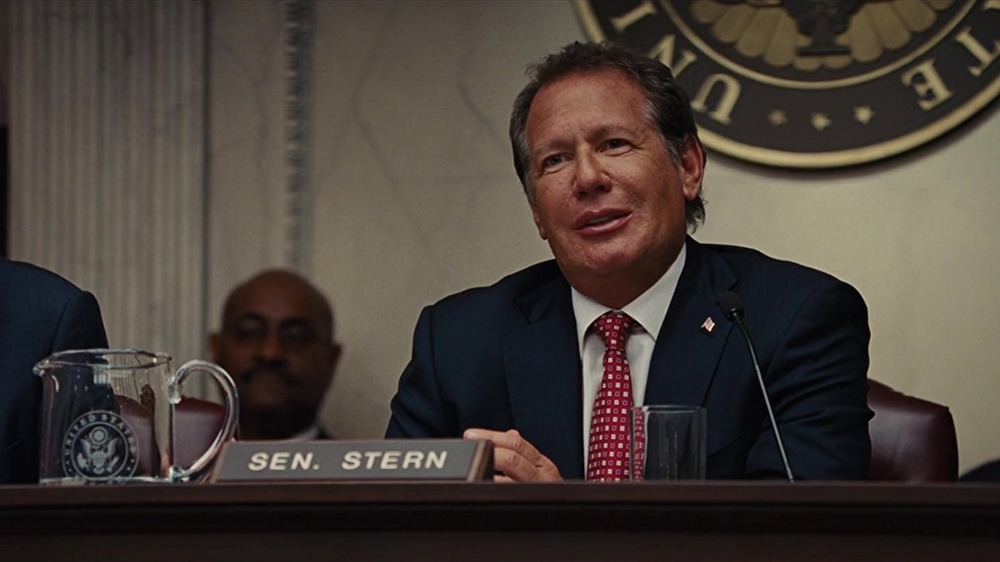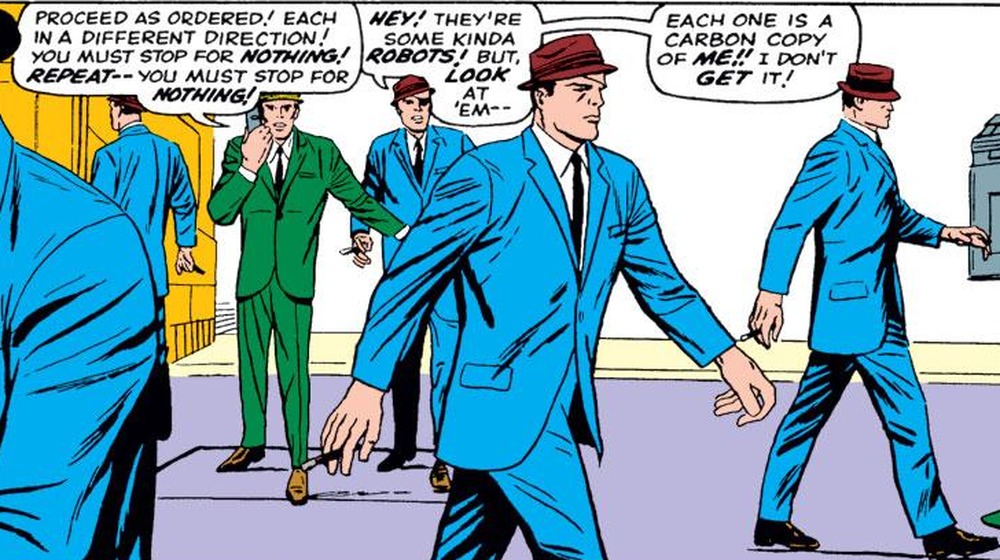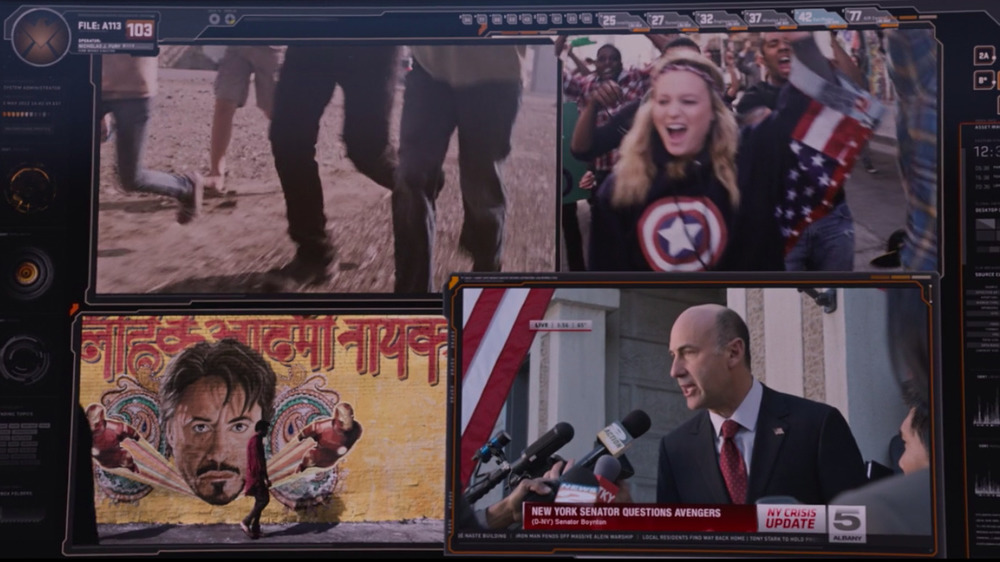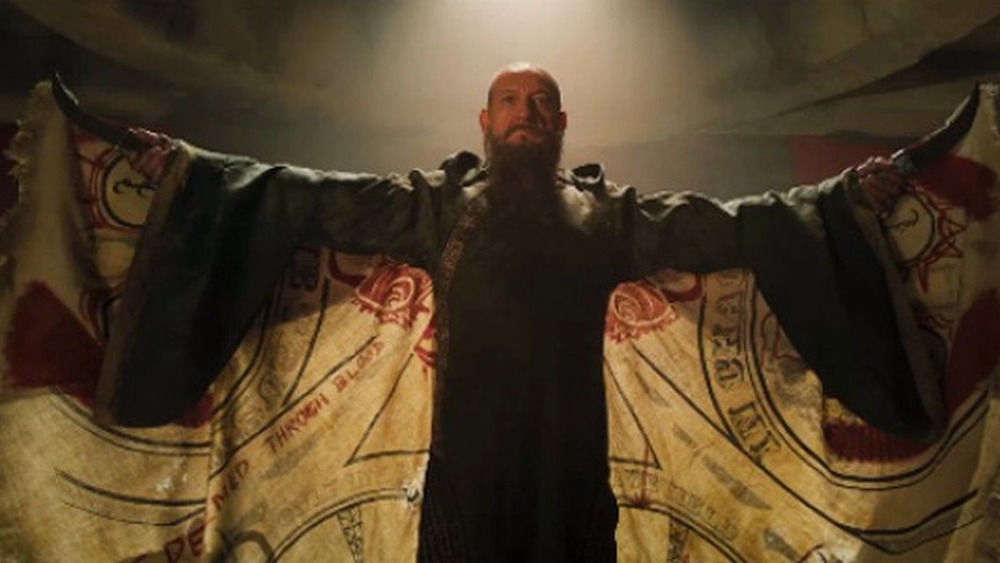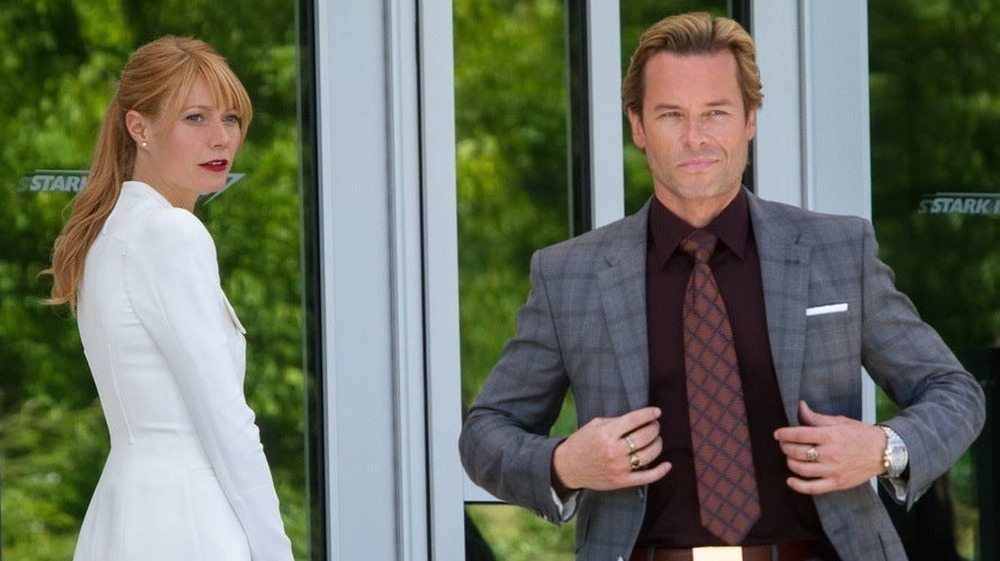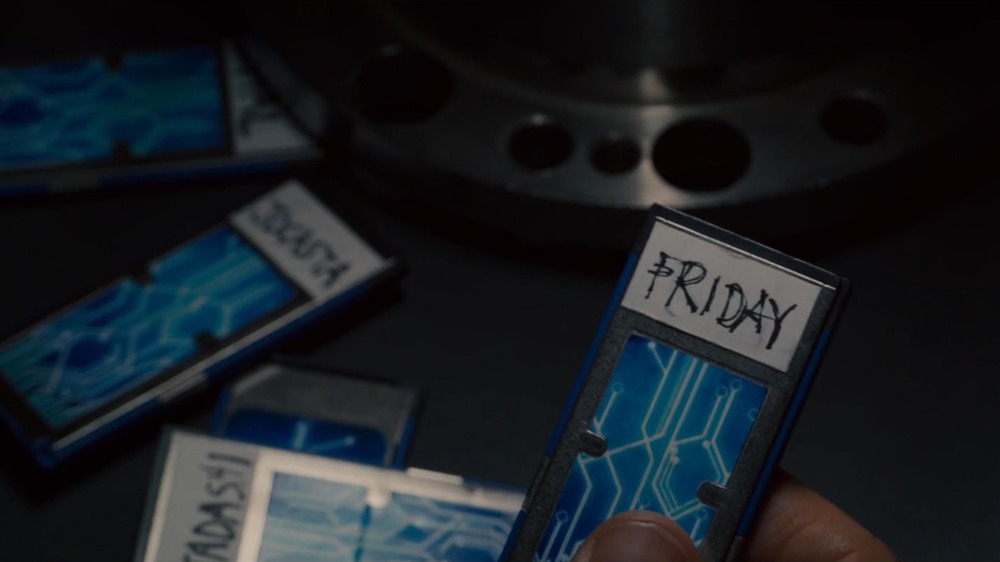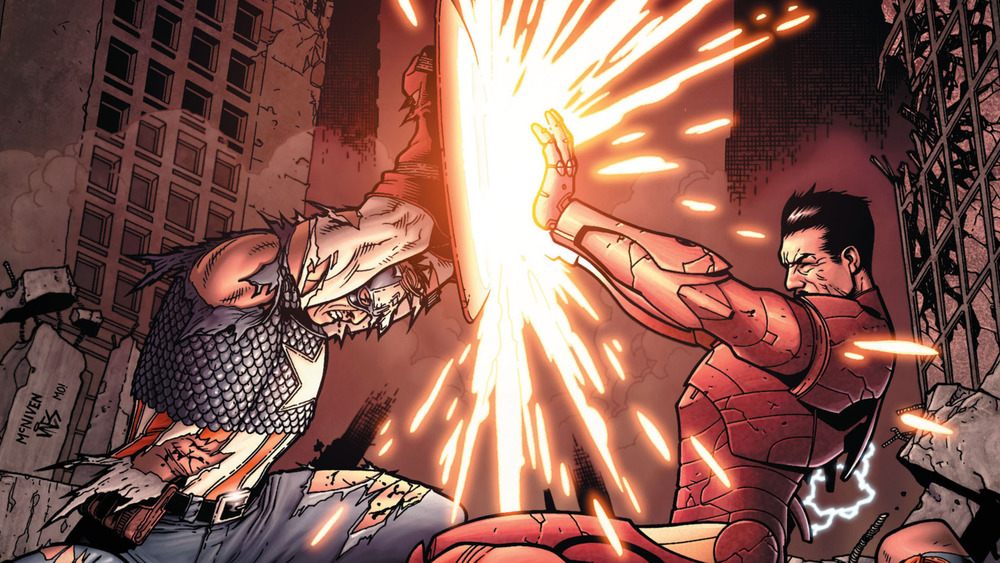The Best Iron Man Easter Eggs In The MCU
We've all seen Iron Man flying around to save the world with his repulsor rays and high-tech armor. But how closely have we been watching him? The Marvel movies are expertly designed to deliver maximum surface pleasures, but that isn't all they have to offer. Dig a little deeper, and you'll find the backgrounds of Tony Stark's adventures are full of hidden details.
You may have to wear out your pause button trying to catch them all. You may be left in the dark if you're not already a fan of the comic book source material. And even if you are a fan, you may still not know what you're looking at because odds are you're not as big of a fan as the filmmakers. Fortunately, we've combed through the Iron Man and Avengers movies to find all the little things you may have missed and narrowed them down to this — the best Iron Man Easter eggs in the Marvel Cinematic Universe. Just know that we'll be sharing some spoilers along the way.
The terrorists from Iron Man fly a significant flag
In summer 2021, Marvel is debuting a new hero, Shang-Chi, the Master of Kung Fu, by pitting him against the legendary Ten Rings. But that organization has already been part of the MCU for a long time. Iron Man 3 featured a counterfeit Ten Rings created by Aldrich Killian. And the actual terrorist group tangled with Iron Man well before that, at the very beginning of the Marvel franchise.
Tony Stark is forced to create the first Iron Man armor when he's held hostage by terrorists in Afghanistan. Their hideout is decorated with a flag displaying ten rings encircling two crossed swords — the same one featured in Ben Kingsley's intimidating videos as the faux Mandarin. And it's not just movie foreshadowing — it's also a nod to comics history. The original Mandarin gained his powers from a set of rings he stole from a dying alien — ten of them. And despite their Afghan origins, the terrorists' flag prominently features Chinese characters, further tying them to the South Asian supervillain, who's named after the lords of Imperial China. How all this will relate to the real Mandarin, who will appear in the form of Tony Leung, we'll just have to wait and see.
An Iron Man Easter egg pays tribute to a famous rapper
Before Iron Man debuted in 2008, Tony Stark was strictly a second-string Marvel hero — a staple of the Avengers team but rarely a hit on his own. But since Marvel had already sold off the movie rights to all their best characters, they pushed Iron Man as the star of their new movie studio. And thanks to the combination of Robert Downey Jr.'s classic performance and the media hype around his comeback, it paid off.
But even before Iron Man became a big screen star, there was already one man keeping him in the public eye. That was Ghostface Killah, part of the legendary Wu Tang Clan. He loves comics just as much as his bandmates love kung fu movies, and Iron Man is his favorite out of all of them. Like many rappers, he's gone by many names, including Tony Starks, Starky Love, and just plain Ironman, which is also the name of one of his most popular albums. He even recorded some songs like "Slept on Tony" that retell the story of the comics. Marvel returned the favor on the Iron Man soundtrack, using "Slept on Tony" to score Stark and Rhodey's party on his private jet.
Tony races the X-Men's jet
One of Iron Man's most memorable scenes has Tony testing his new, upgraded armor by flying high above Los Angeles. That scene should be even more memorable for eagle-eyed X-Men fans. Tony decides to find the top speed of his new armor by testing it against the capabilities of the SR-71 Blackbird jet. It's one of the most powerful planes on the market, but that's not the only reason the model appears in the movie.
The X-Men have been flying that same jet ever since S.H.I.E.L.D. lent them one in 1977's X-Men #104. The Marvel crew would've known this was the closest they could get to a crossover since they'd already sold the movie rights to their Merry Mutants to 20th Century Fox years earlier. That's no longer the case after the Fox-Disney merger. But since Iron Man sacrificed his life for the universe in Avengers: Infinity War long before any plans to reunite the two universes were announced, it seems like this will have to do for now — unless there are some necromantic shenanigans involved, and in the MCU, that's always a possibility.
Obadiah Stane plays a rather ironic song
In Iron Man, Jeff Bridges plays Tony's villainous business partner, Obadiah Stane. Stane had run Stark Industries until Tony came of age, and he wants the company back in his own hands, even masterminding his rival's abduction by the Ten Rings.
Stane is intensely jealous of the younger man to whom brilliance, sex, and fame come so easily. In other words, he has a lot in common with Antonio Salieri, a real-life composer and the protagonist of the Oscar-winning classic Amadeus. Milos Forman's movie imagines a rivalry between Salieri, a self-admitted "mediocrity," and the legendary composer Wolfgang Amadeus Mozart. In the film, Salieri is tormented by seeing Mozart — portrayed here as an empty-headed playboy — gifted with the transcendent genius he can never achieve, and he plots to literally work Mozart to death.
That connection obviously wasn't lost on Iron Man's filmmakers. In one scene, Tony walks into his apartment to find Obadiah playing at his piano. Multiple sharp-eared fans have identified the piece he's playing as part of Piano Concerto in C major by — guess who? — Salieri.
Tony flies past a major Marvel landmark
Iron Man features some stunning action scenes. It's easy to focus on all the excitement in the foreground, but don't let that distract you from everything going on elsewhere. In the climax, Obadiah Stane succeeds in creating his own Iron Man armor and battles Stark across the Los Angeles skyline. That skyline includes some buildings that don't exist in real life, like one with "Roxxon" written in big letters across the roof. That name reappears in all three Iron Man movies — as a sponsor at the Monaco racetrack where Tony meets Whiplash in Iron Man 2 and as the bosses of a corporate executive the Mandarin executes in Iron Man 3. Roxxon's also popped up in several of Marvel's TV spinoffs, but it has a much more involved history in the comics.
Roxxon first appeared in Captain America #180, way back in 1974. In that comic, it was just a thinly veiled stand-in for the real-life oil company Exxon, and its CEO was an innocent victim of the supervillainous Serpent Squad. Since then, Roxxon has evolved into Marvel's all-purpose evil corporation, expanding past the oil industry into subsidiaries like Rox News and gaining a near-monopoly on social media. It played a major role in the Marvel Universe recently, as it was taken over by Dario Agger, aka the Minotaur, who helped mastermind Earth's invasion by otherworldly forces in 2018's War of the Realms crossover.
This Iron Man Easter egg calls back to Happy Hogan's old career
In addition to directing the first two Iron Man films, Jon Favreau plays Tony Stark's personal assistant, Happy Hogan. He wears a lot of hats in that role, including chauffeur, bodyguard, and, in one scene in Iron Man 2, boxing trainer.
Hogan has a long history in the comics, almost as long as Iron Man himself, and boxing is a major part of it. In his first appearance in 1963's Tales of Suspense #45, Hogan reveals he used to be a prizefighter. He even got his name in the ring, as an ironic reference to his gloomy attitude. Out of work, he finds himself a new job when he rescues Tony Stark from the burning wreckage of a race car — much like the cinematic Happy does in Iron Man 2. Happy turns down Tony's offer of a cash reward for a job on the inventor's staff — one he's had ever since.
Anton Vanko's defection is a sneaky Iron Man Easter egg
With Obadiah Stane out of commission, Iron Man 2 finds a new villain for Tony Stark. Mickey Rourke plays Russian scientist Ivan Vanko, aka Whiplash. He wants revenge on the Stark family for the way Tony's father Howard betrayed his own dad, Anton. The elder Vanko defected from the Soviet Union to the United States, where he helped Howard Stark design the arc reactor. But Howard discovered Anton only cared about the potential profits instead of the humanitarian possibilities. Worse still, he was selling secrets to the Kremlin. So Stark turned Anton back over to the Russian authorities, who sent him to Siberia.
After meeting Whiplash, Tony searches his data banks to put all this backstory together. When he does, look closely at the newspaper reporting on Anton Vanko's defection to the West. It's dated March 1963 — which is when Iron Man made his first appearance in the pages of Tales of Suspense.
Whiplash poses as another Marvel villain
Ivan Vanko makes his first attack on Iron Man at a Monaco racetrack, where he disguises himself as a racer whose jacket tells us is named B. Turgenov. While that might seem like a throwaway detail, the name comes from Boris Turgenov, a minor character who had a major impact on the Marvel Universe.
In Tales of Suspense #52, Ivan Vanko, Whiplash's namesake and the Russian inventor of the Iron Man-inspired Crimson Dynamo armor, defects from the Soviet government to Stark Industries. That's when the Kremlin sends Boris Turgenov and Natasha Romanov to assassinate Vanko before he can reveal their secrets. Boris' partner would go on to defect herself, becoming the heroic Black Widow. And just as her adventure with Boris was her first comics appearance, Iron Man 2 was her first film appearance.
As for Boris, he ends up taking the Crimson Dynamo armor for himself, but he doesn't get far before Vanko shoots him.
Senator Stern takes his name from a classic Marvel writer
At the same time he's fighting with Whiplash and his corporate ally, Justin Hammer, Iron Man faces a battle on another front, with a Senate subcommittee trying to requisition Tony's tech. Here, Garry Shandling leads the charge as Senator Stern.
Stern is an original character Favreau and screenwriter Justin Theroux created specifically for Iron Man 2. However, the senator does indeed have a comics connection. He most likely takes his name from Roger Stern, a legendary Marvel writer who edited Iron Man through some of the hero's most classic stories, including the groundbreaking exploration of alcoholism in Demon in a Bottle, before cowriting the series with Kurt Busiek at the turn of the millennium.
However, he's best known for his work with some of Marvel's other heroes, including the Avengers epic Under Siege and a long run on Spider-Man that includes classic adventures like The Kid Who Collects Spider-Man and Nothing Can Stop the Juggernaut. That's quite a legacy, and if naming a weaselly government stooge after him isn't quite the nicest tribute you could give, we're sure he appreciates it just the same.
Iron Man's excuse isn't as flimsy as it sounds
In The Avengers, Iron Man has to share the screen with the rest of Marvel's greatest heroes, but his razor-sharp wit is still in fine form. The hero is introduced trying to enjoy a nice evening with Pepper Potts when Agent Phil Coulson interrupts to call him in to deal with the theft of a powerful artifact called the Tesseract. It's a video call, but Tony still tries to convince Coulson he's gotten the answering machine by saying, "You have reached the life model decoy of Tony Stark, please leave a message."
This may just be Tony being whimsical, but life model decoys are a very real thing in Marvel Comics. Developed by S.H.I.E.L.D., they're robotic doubles good enough to fool any enemy agent into thinking they've shot down the real thing. They'd eventually appear in the MCU over on Agents of S.H.I.E.L.D. So maybe Tony wasn't being whimsical — could he have discovered some secret files he wasn't supposed to know about?
The Avengers provides an Armor Wars Easter egg
No Marvel character is too obscure to make it to the screen. The Avengers ends in the aftermath of the team's battle against Loki's Chitauri invaders with a montage of news clips reacting to everything we've just seen. One of them features a Senator Boynton, demanding the Avengers be held responsible for the damage done to New York City.
That's not just a name. Boynton had last appeared decades earlier in the pages of Iron Man's "Armor Wars" storyline, where Tony discovers a mystery supervillain has been stealing and selling his designs. Tony's fight for control of his inventions leads him into conflict with some US government agents, and soon, he's on the enemies list.
In Iron Man #229, Senator Boynton meets with Stark's corporate rival, Edwin Cord, to discuss his plans to build a government-approved Iron Man called Firepower to take the original out. Unfortunately for him, Boynton decides to share this plan in the next issue with Tony Stark himself, who was still successfully protecting his secret identity at the time, giving Iron Man plenty of warning that Firepower is coming for him.
The Mandarin uses a teleprompter
Fans are still arguing over the shocking twist in Iron Man 3, where the Mandarin turns out not to be a formidable mastermind and Iron Man's most persistent enemy in the comics but a British actor named Trevor Slattery. Some viewers were thrilled at writer/director Shane Black's subversive upending of the xenophobic stereotypes that inspired the Mandarin character. Others felt cheated out of a superpowered beatdown.
But however you feel, you can't say it came out of nowhere. If you watch Iron Man 3 again knowing who the Mandarin really is, you'll see Black laid the groundwork all along the way. Watch carefully when the Mandarin records one of his Osama Bin Laden-esque threatening video messages, and you'll see a teleprompter hanging around the set. Who's ever heard of a terrorist using a teleprompter? None of us have ... but it makes perfect sense if he's just an actor having lines fed to him by the real mastermind.
Killian's jewelry choices foreshadow his real identity
If Trevor Slattery isn't really the Mandarin, who is? The answer turns out to be Aldrich Killian, head of the think tank Advanced Idea Mechanics (A.I.M.). He's created an imaginary terrorist to take the blame for the explosions caused by Extremis, a technology he's developed that creates super soldiers with an unfortunate tendency to spontaneously combust. Under Killian's leadership, A.I.M. has become powerful enough to take control of the United States, with a vice president under their thumb and plans to assassinate the president underway. And if Tony Stark ends up as collateral damage, all the better. Killian's had it in for the inventor ever since Tony snubbed him at a conference years earlier.
And Killian's true identity is foreshadowed all along the way. Killian is single, but he still wears an awful lot of rings. There's not quite ten, but it's enough for a sharp viewer to connect him to the Ten Rings just the same.
Tony keeps a classic Avengers character in his stash of AIs
In Avengers: Age of Ultron, Tony is convinced that he needs to create new measures to protect the Earth. Unfortunately, his first attempt ends up creating Ultron, who, with access to all the knowledge available on the internet, quickly goes off the rails and decides the best way to protect the Earth is to end all life on it. When Ultron gains consciousness, he first attempts to murder Tony's artificial intelligence, J.A.R.V.I.S. But J.A.R.V.I.S. survives, and Tony uploads it into an artificial body Ultron wanted for himself, creating the Vision.
This leaves Tony without an AI for his suit, so he rummages through his drawer for a new one. Before he settles on FRIDAY, we see some of Tony's other options, including one drive marked "Jocasta." In the comics (specifically The Avengers #162), Ultron himself created Jocasta to be his bride, kidnapping the Wasp to transfer her mind into a robot body. The Avengers rescued Wasp, apparently deactivating Jocasta, but Ultron revived her later in Marvel Two-in-One #92, only for her to eventually join the Avengers herself. More recently, Jocasta has joined up with Stark Unlimited, where she joined the AI Army and helped Tony save the world from his brother, Arno.
Captain America: Civil War recreates a classic Iron Man moment
Captain America: Civil War shares a name and several plot points with the 2006 crossover masterminded by Mark Millar, but it's such a loose adaptation it's probably not worth calling it one at all. There are a few scenes, though, that directors Joe and Anthony Russo adapted very closely.
In the cinematic Civil War, tensions are already high among the Avengers over the proposed Sokovia Accords that would give the US government closer control over the team and what they mean for the Winter Soldier, Captain America's war buddy who's been recently freed from HYDRA's control. Then Helmut Zemo decides to inflame those tension further to get revenge for the Avengers' failure to save his family from Ultron's attack on Sokovia.
It all comes to a head when Zemo reveals the Winter Soldier murdered Tony's parents. As a result, Iron Man lashes out at Steve Rogers in a harrowing fight that includes one shot that comics fans should find very familiar. Captain America uses his shield to block a beam from Iron Man's hands — just like he does on Steve McNiven's cover for the final issue of Civil War.
